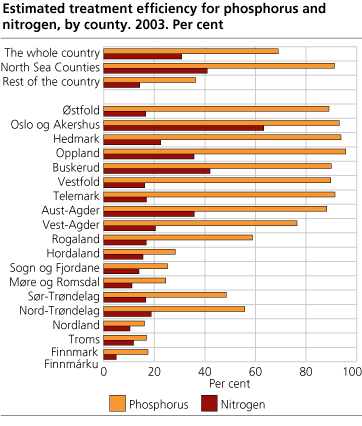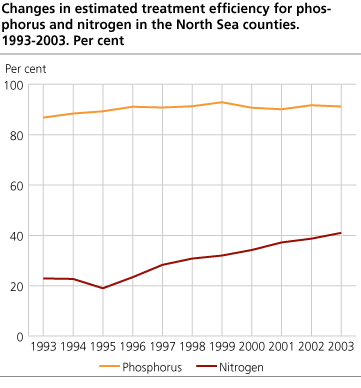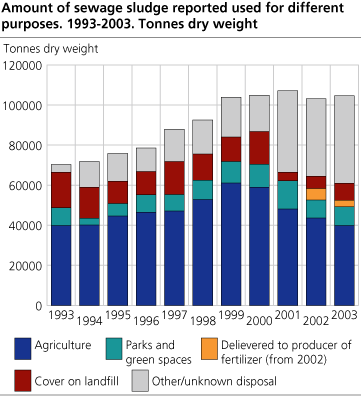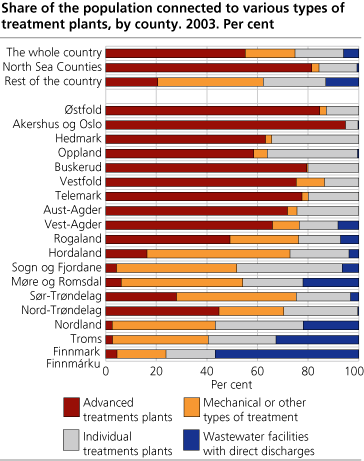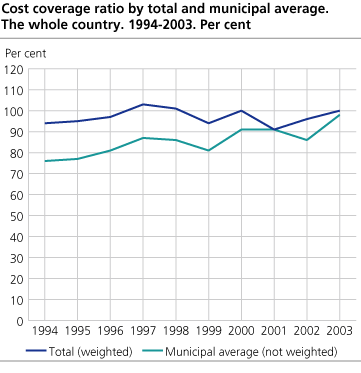Content
Published:
This is an archived release.
"Polluters pay" applies in municipal wastewater sector
The wastewater treatment sector posed a cost of about NOK 4.28 billion to the municipalities in 2003, now balancing the revenues municipalities receive in wastewater fees. The treatment plants continue the positive trend of removing increasingly more nitrogen from wastewater. The portion of the population, who is connected to high-grade treatment plants, remains unchanged.
In 2003, a total of 2 549 municipal sewerage systems were registered with a capacity of 50 p.e or more, whereof 1 991 carried out some type of treatment, while 558 discharge wastewater without any form of treatment (direct discharges). The 2003-statistics reveal that the trend from the 1990scontinues, with a continuous improvement on nitrogen removals and a stabilized sufficient removal of phosphorus.
Regional differences
International obligations (North Sea declaration and OSPAR-convention) have resulted in nitrogen-removal requirements for certain treatment plants, plus supporting the demands on removal of phosphorus.
For 2003, the discharges of phosphorous and nitrogen from municipal sewerage systems have been estimated to 756 tonnes and 11 426 tonnes respectively. In relation the North Sea counties (from Østfold to Vest-Agder), the discharges originating from municipal sewerage sector have been estimated to be 134 tonnes for phosphorous and 5 866 tonnes for nitrogen. As a result of installation of specialised nitrogen removal techniques in larger treatment plants around Oslo and Akershus, these two counties show notably lower discharges of nitrogen per capita compared to the rest of the country.
In 2003, about 80 per cent of the population in the North Sea counties was connected to high-grade treatment plants. For the remaining counties, those without drainage into the North Sea, about 20 per cent were connected to high-grade treatment plants. Counties with mainly scattered settlements; for instance Hordaland, Hedmark and Norland; also has a large population connected to smaller treatment plants (mainly individual plants) with capacity of less than 50 pe. Sludge separators, or alternatively in combination with infiltration or sandfilter, constitute the most common treatment methods for these kinds of plants. This has not changed since 2002.
Same amount of sludge used as fertilizer
In 2003, the municipal reports on sewage sludge show a total of 105 000 tonnes dry weight used for different purposes, an increase of 1.4 per cent more than in 2002. Roughly half of this amount, 50.2 per cent, was used as fertilizer and soil improvement.
Increased investments and full cost coverage
In 2003, gross investment in the municipal wastewater sector were NOK 1.86 billion, and increase of 6.4 per cent since 2002 (measured as current prices). Investments in municipal wastewater treatment have decreased slightly since the peak in 1999, while investments in sewage system (pipelines) have increased gradually one year after another. As for the annual costs, they had increased by 6.8 per cent since 2000, following the same increase in price level as measured by the consumption price index.
More and more municipalities now balance their treatment costs with revenues from wastewater fees. Looking at national totals, the financial income-to-cost ratio was 100 per cent. This means the costs are now covered in full by fees. The underlying reason for this is linked with the increasing focus on full coverage of self-cost when calculating the level of municipal fees.
A handful of independent enterprises are included in State-Municipal-Reporting statistics (KOSTRA), and they are also covered by other statistics on wastewater and renovation:
Turnover statistics in the sewage and refuse sectors
Structural statistics of personal services, hereunder wastewater and refuse activities (NACE 90)
For further information about the economy in municipal wastewater sector, refer Municipal wastewater, economy .
In addition to the tables below, further information may be found in StatBank .
Read also : Analysis of the physical data from the wastewater treatment sector 2003 (Report 2005/6)
Tables:
- Table 1 Number of municipal treatment plants, by county. 2003
- Table 2 Total discharges of phosphorus and nitrogen from the municipal waste water sector, by county. 2003
- Table 3 Disposal of sewage sludge, by county. 2003. Tonnes dry weight
- Table 4 Municipal wastewater sector. Investment, costs, fee income, and cost coverage ratio. 1993-2003. Current prices
- Table 5 Municipal wastewater sector. Investment, costs, fee income, and cost coverage ratio, by county. 2003
Contact
-
Gisle Berge
E-mail: gisle.berge@ssb.no
tel.: (+47) 48 12 19 97

